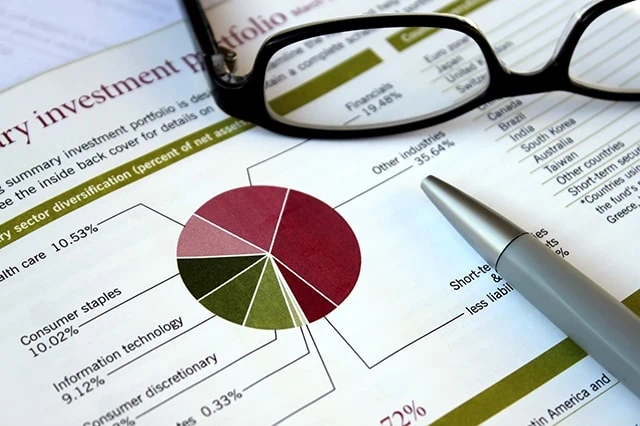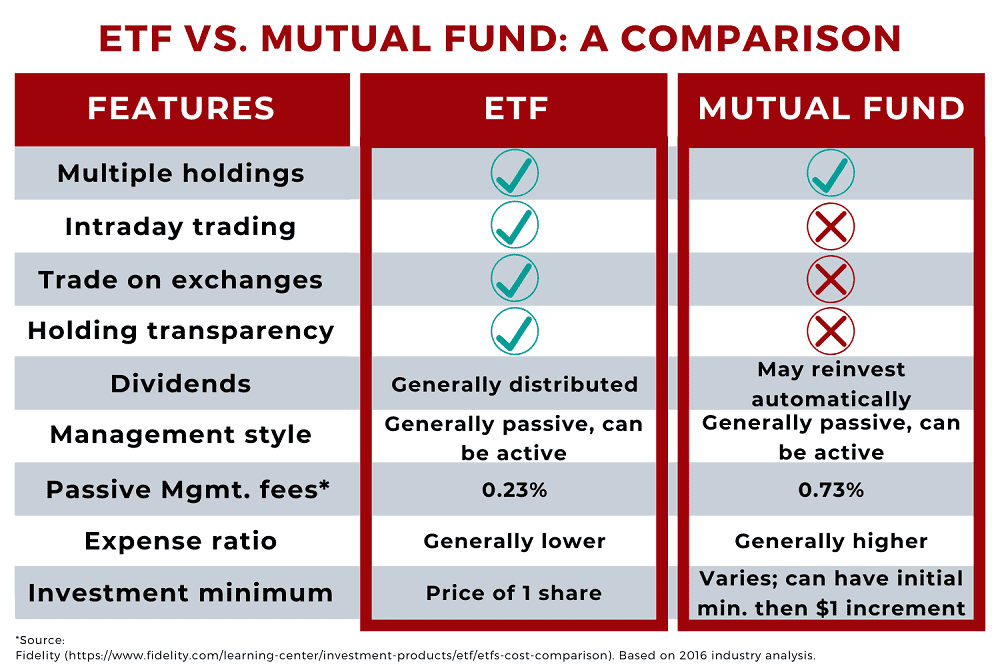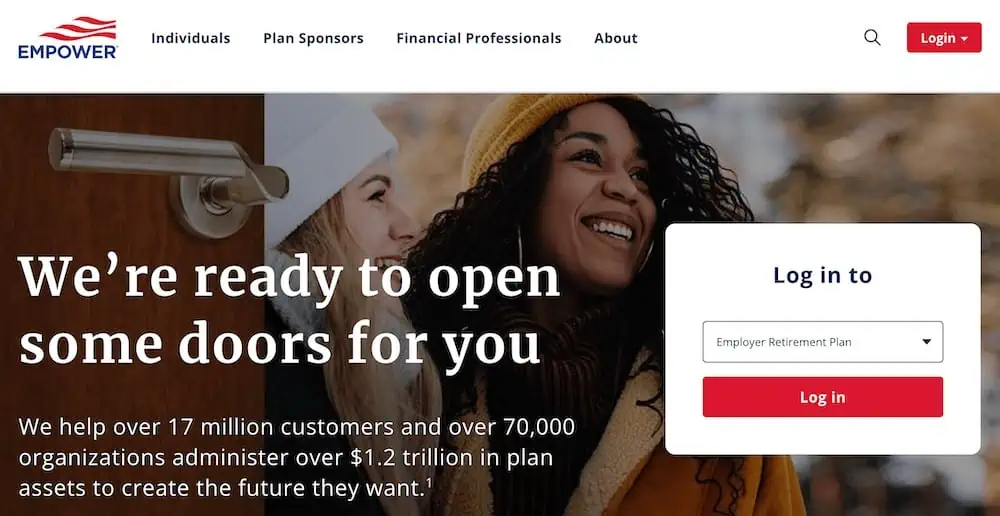When you desire to increase your financial worth, you can trade your time for an income, invest money you currently have, or both. For longer-term goals, investing acts as a wiser choice because inflation will work in your favor, assets can greatly increase in value over time, and you can benefit from distributions.
Investments make your money work for you, even allowing you to make money while you sleep. You have access to an extensive range of investment vehicles and they vary in the levels of risk and volatility.
Read below for the best financial vehicles you should consider right now.
Table of Contents
Featured Financial Products
What are the Best Types of Investment Vehicles?

Investment vehicles allow you to place your money into assets that aim to accomplish their stated investment objective. You have a wide variety of options available to you for meeting these needs. The best investment vehicles will meet your specific investment needs and align with your risk tolerance. Make sure you understand the risks involved with investing in specific investment vehicles before proceeding with your investment.
Consider the following investment vehicles below and if they meet your financial goals, both short, medium and long-term.
1. Bonds

Bonds act as a specific type of debt. They offer a lower return than many of the other investment vehicles mentioned in this article, but they represent one of the safest investments you can make. Of course, this depends on the quality of the company or institution issuing the bonds.
Many different types of bonds exist. The safest type of bond comes from the federal government. Treasury bonds, also known as T-bonds, in particular. These bonds come backed by the full faith and credit of the U.S. government. In other words, should the federal government become suddenly unable to repay their debt, they can take a number of actions to ensure you receive payment.
This implicit guarantee makes investors turn to Treasuries in times of economic duress or financial uncertainty. T-Bonds come with 20 or 30-year maturities, pay interest twice a year and return the face value when the bond matures. Throughout the year, the Treasury department sells T-bonds at auction and uses this event to determine the price and yield of this particular issuance of bonds.
The value of bonds depends on interest rate movements. When rates fall or rise, their value fluctuates. Because bonds’ yields and price move inversely, when rates rise, newly issued bonds have a higher return than existing bonds. In response, existing bonds will fall in value because newer bonds pay higher rates of interest. Investors expect a lower price to compensate for the lower interest payments they can receive from existing bonds.
Fortunately, the T-bond market carries a significant amount of liquidity. Some even use them as a guide for future market direction. However, as noted above, if you sell your bond before maturity, you may recognize a capital loss.
Further, if a security’s interest rate carries a return lower than inflation, investors lose purchasing power. Don’t let these facts deter you. Overall, Treasury bonds still represent one of the safest investments you can make.
You can buy them directly from the U.S. Treasury Direct or through an online discount broker, bank, or dealer.
Do you want to get serious about saving and planning for retirement? Sign up for Retire With Riley, Young and the Invested’s free retirement planning newsletter.
2. Individual Stocks

Compared to bonds, partaking in individual stock picking is a significantly riskier choice. Individual stocks represent portions of companies, such as Amazon or Apple. You earn money through stocks when you buy them at a certain price and sell them later when the stock price increases. In effect, using the buy low, sell high investing strategy.
Conversely, you can also capitalize on downward price movements by short selling. Effectively, you sell borrowed stock at a higher price and repurchase it for less when the stock falls in value. You return the lower-priced shares to the lender and keep the difference as a gain.
Some stocks also pay dividends to shareholders. If you hold the dividend-paying stocks long enough, they can become qualified dividends and provide you with a source of passive income.
Buying individual stocks with free stock trading apps can carry a couple of advantages.
- In particular, by using a commission-free broker like E*Trade to invest, you can create a portfolio of individual stocks.
- Further, you will have more control over where your money goes and the chance to capture alpha by doing better than the general stock market.
As for disadvantages, they include:
- increased difficulty diversifying your portfolio
- having more responsibility to make gains, and
- greater time commitment to screening stocks.
If you choose to invest in individual stocks, make sure to research potential stocks thoroughly with the best investment analysis websites. Stocks can bring high gains when carefully selected and held for sufficient amounts of time. However, if chosen poorly, they can also result in substantial losses.
Consider starting with some of the best stock trading apps for beginners, including an app like E*Trade.
Related: Best Brokerage Account Sign-Up Bonuses, Promotions and Deals
3. Exchange-Traded Funds (ETFs)

Exchange-traded funds (ETFs) have gained a significant amount of popularity in recent years. These financial instruments hold groups of assets (usually stocks, but also bonds or other assets) by pooling money with other investors to purchase financial instruments, benchmarks or other investment strategies laid out in an ETF’s prospectus.
Buying ETFs can quickly, cheaply and easily diversify your portfolio. However, for the best diversification, you will need to understand how multiple ETFs may overlap and have similar holdings. Investments like Vanguard’s Total Stock Market Index Fund (VTI), one of Vanguard’s best ETFs, can comprise a portfolio’s entire equity allocation if you desire because it represents an investment in over 3,500 U.S.-listed companies.
Typically, these funds mirror established indices without active management, however, their investment strategies can differ. Further, they can also employ margin to leverage the movement of the ETF in relation to the underlying index or portfolio of holdings.
Like stocks, investors can exchange ETFs throughout the trading day. Investors can buy and sell these securities any time during market hours. If carefully selected, these funds usually consist of secure, long-term investment options. They work well under a simple, buy-and-hold strategy for building wealth over significant periods of time.
ETFs also have some major tax advantages. You only recognize capital gains tax in years where you sell an ETF and not throughout the life of the investment. When these investments produce income in the form of dividends, however, you will need to pay income tax in the year received.
Featured Financial Products
4. Mutual Funds

Like ETFs, mutual funds represent groups of assets (often stocks, but can be bonds or other assets) you purchase through pooling money with other investors. These two investments act as types of pooled investment vehicles. While similar to ETFs, mutual funds have some notable differences.
Primarily, instead of exchanging mutual funds throughout the day, mutual funds only trade at the end of the day at market close. This means that you pay the same price as everyone else, no matter what time of day you place your order.
Another key differentiator comes down to the management style of most mutual funds. Traditionally, mutual funds had high management fees because most employed an active management style, where investment managers chose stocks according to their research and not in accordance to some index or benchmark. This stock picking can not only lead to higher costs, it can also show dramatic underperformance as compared to following a simple index.
As a further breakdown of how ETFs and mutual funds differ, have a look at the chart below.

Whether you prefer ETFs or mutual funds, you can purchase different types of the same investment with funds like VTI and VTSAX. By using an investing app like E*Trade, you can purchase ETFs, individual stocks and more to provide instant diversification to your portfolio. Over time, holding low-cost, diversified assets can prove some of the best investments for young adults.
5. Cryptocurrency

As many millennials found out at the end of 2017, cryptocurrency markets come jam-packed with volatility. First with bitcoin, and now with “altcoins.” However, investing in cryptocurrency has lucrative potential and many investors think crypto represents the future.
Undoubtedly, you’ve likely heard stories of people who have made considerable gains in the crypto markets. While I don’t recommend putting all of your money in this type of investment vehicle (or even a significant amount), you might consider:
- investing in cryptocurrencies,
- lending your crypto assets, or
- funding crypto-linked investments
Investing in crypto in any of these manners can make a great addition to your portfolio because of the potential of above-average returns. I walk through each option briefly below.
→ Investing in Cryptocurrencies
For those who wish to purchase cryptocurrencies, you can use apps like eToro. While Robinhood offers some mainstream cryptocurrency options, this Robinhood alternative has more than a shortlisted set of cryptos to pick from.
When it comes to cryptocurrency, you usually make more the earlier you invest. Simply look at any 5-year chart and see the power returns in most existing cryptos with a track record going back that far.
Personally, I have a greater level of risk aversion and would only consider investing in more stable, established cryptocurrencies like Bitcoin (BTC) or Ethereum (ETH). However, eToro offers many more types of cryptocurrencies (28 as of this publication), comes with a $100,000 paper trading simulator and has no hidden fees.
Open your account and make a deposit to start exploring crypto investing today.
- The eToro trading platform allows you to buy and sell stocks, ETFs, and options with 0% commission, including no contract fees on options.
- Trade dozens of the most popular cryptocurrencies.
- Not sure what kind of trading strategy you want to employ? eToro allows you to replicate the trades of popular traders automatically, in real time.
- Test out your strategies with eToro's $100,000 practice account.
- $100 minimum deposit to get started.
- Special Offer: Get $10 when you deposit $100 or more.*
- Good selection of available investments
- No options contract fees
- Fractional shares
- Copy trading functionality
- Strong technical analysis tools available
- $100,000 virtual portfolio included for free
- Charges withdrawal fee ($5)
- Doesn't offer robust fundamental tools
- Unavailable in 4 U.S. states (NY, NV, HI, and MN)
Do you want to get serious about saving and planning for retirement? Sign up for Retire With Riley, Young and the Invested’s free retirement planning newsletter.
6. Certificates of Deposit (CDs)

Certificates of deposit (CDs) are federally insured savings accounts which come with a fixed interest rate for a predetermined amount of time. CDs are insured in the United States up to $250,000 and are one of the safest short-term investment vehicles you can have. The interest rate typically comes higher than you would earn with the same amount of money in a high-yield savings account and the longer you loan your money, the more you earn.
This investment vehicle is best for money you know you’ll need at a fixed date in the future, such as a wedding or home down payment. These aren’t designed to be short term investments and if you take money out before the term length is over, you’ll face a penalty. CDs don’t have as high of a return as other options, but you’ll know exactly how much you’ll make. You can open certificates of deposits with most banks.
Consider opening a CD with an online-only bank like CIT Bank. Because they don’t maintain a physical branch network, they can typically pass along these cost savings to depositors like you in the form of higher interest rates.
- CIT Bank is an online bank which offers competitive interest rates on its multiple products
- Earn many times more than the national average interest rate by keeping your cash and other savings in one of CIT Bank's banking products
Related: Best CD Alternatives to Consider
7. Money Market Accounts
Money market accounts, also referred to as money market savings accounts or money market deposit accounts, are similar to online savings accounts. However, you usually aren’t allowed to withdraw money more than six times each month. Sometimes you are also required to have a more substantial minimum amount in the account than required for savings accounts.
In exchange for the lack of flexibility, these accounts offer higher interest rates than savings accounts. Don’t confuse money market accounts with money market mutual funds or money market funds as these are different. Money market funds aren’t insured by the FDIC or NCUA, unlike savings accounts or money market accounts.
Featured Financial Products
8. Real Estate

There are several advantages to real estate investments. These appreciating assets hedge against inflation, have several tax advantages and can provide a predictable cash flow. One common real estate investment vehicle is a real estate investment trust (REIT).
REITs are companies that own, and usually operate, income-producing real estate. They can possess a variety of commercial real estate, from apartment buildings, to hospitals, to hotels, and more. A benefit to REITs is that they tend to be uncorrelated with stocks, meaning when one part of your portfolio is down, these may be up. You make money from dividend payments and can sell your shares for profit when their value increases.
Another way to make money through real estate is by investing through an online investment company, such as Fundrise. With a minimum of only $10, FundRise helps you invest in a diverse portfolio of real estate projects. While any type of investment holds an inherent risk, FundRise takes a conservative approach with the intention of having the ability to withstand long periods of economic distress.
Real estate investing is no longer just for the very wealthy, it’s a top financial vehicle for investors of nearly any income level. However, if you find yourself more attracted to investing in commercial real estate opportunities and can be considered an accredited investor, you might want to review a service called EquityMultiple.
This service allows you to invest in specific pieces of real estate as opposed to a broader portfolio approach used on FundRise. While this can carry higher levels of risk for concentrating your investment in one asset as opposed to many, it can also result in greater potential returns.
(As stated prior, EquityMultiple caters to accredited investors, or those who have an aggregate net worth of over $1,000,000 and earn over $200,000 per year in each of the two most recent years with a reasonable expectation of earning this level of income in the current year.)
Note: Individuals can also qualify as accredited investors based on specific financial credentials or holding positions with investment firms.
Related: Qualified Purchaser vs. Accredited Investor
9. Health Savings Account (HSA)

If you currently use a high-deductible health insurance plan, a health savings account is an extremely valuable investment vehicle. It carries a triple tax advantage because contributions are tax-deductible, returns realized are tax-free, and you aren’t taxed on withdrawals for qualified medical expenses.
However, if you withdraw funds and use them for something unrelated to medical purposes before age 65, you’ll have to pay a 20% penalty. Past age 65, you can make withdrawals for any reason and don’t pay a penalty. You’re never forced to take distributions and unused money in your HSA rolls over each year indefinitely.
To qualify to open an HSA, in addition to being under a high-deductible health insurance plan, you can’t receive Medicare or be claimed as a dependent on anybody’s tax return. Ask your preferred insurance provider if they offer health savings accounts.
One increasingly popular option is Lively. This service helps people to prepare for their future financial needs by setting aside funds in a health savings account. Lively charges no fees for individuals and families, offers secure contributions and effortless transfers between accounts, provides FDIC-insured deposits when held in their Lively savings account, and comes equipped with support when you need it.
- Maintenance/other recurring fees: None
- Investment fees: Schwab Health Savings Brokerage Account: $24/yr*. HSA Guided Portfolio: 0.50%/yr.
- Minimum balance to invest: $0
- Investment options: Stocks, bonds, mutual funds, ETFs (investments depend on account type)
- Maximum investment flexibility via self-directed Schwab HBSA
- No minimum balance to invest
- Low fees for mutual funds available in HSA Guided Portfolio
- Powerful, intuitive mobile app
- Bill pay
- FDIC-insured cash accounts
- SIPC-insured investment accounts
- High Trust Pilot Rating (Especially relative to competitors)
- HSBA fees are high (on a percentage basis) for low- to mid-balance accounts.
- HSA Guided Portfolio fees are high (on a percentage basis) for mid- to high-balance accounts.
Do you want to get serious about saving and planning for retirement? Sign up for Retire With Riley, Young and the Invested’s free retirement planning newsletter.
10. Fine Art

Global art sales reach tens of billions of dollars every year. According to last year’s Art Basel and UBS Global Art Market Report, art sales have continuously increased, especially in online marketplaces. The report also showed that, in some parts of the world, Millennials make up a significant portion of fine art collectors.
While fine art used to be an investment reserved for the ultra wealthy, it has become more accessible for people with less to invest. People who can’t afford to purchase blue-chip artwork can now buy shares of fine art through Masterworks. The minimum investment is only $1,000 for partial ownership of pieces created by Claude Monet, Banksy, and other famous creators.
Rather than doing endless research yourself, the experts at Masterworks carefully choose art based on the level of risk involved and potential appreciation in value. The paintings display in their galleries until sold, making them available to the viewing public. Once a painting you’ve invested in sells, you receive your share of the proceeds.
However, it can take years for art to sell, so this should only serve as a long-term investment in your portfolio. Fine art can involve significant risk and therefore should not represent the primary investment in your portfolio. Investing in fine art carries no guarantees that you’ll make a large profit.
However, it can be a great addition to a well-rounded investment portfolio, especially if you’re passionate about art.
- Masterworks allows investors to buy shares in art selected by the platform's team for both high quality and strong value.
- The service offers a secondary market where investors can sell shares if they want to exit their investment early.
- Provides an easy way to invest in art
- Access to dedicated support representative
- Investing requires a call screen consultation
- High fees
- High minimum investment per offering ($15,000), though it can be waived to as low as $500 on a case-by-case basis
11. Fine Wine

If you enjoy wine, investing in fine wine might be a satisfying investment for you. Because wine doesn’t have much connection to the stock market, it can work well as an alternative investment option to diversify your portfolio. Over the last 40 years, wine has outperformed the S&P 500 and was only down five of those years.
While fine wine can be lucrative, it can also be tricky to buy and resell on your own. It’s easy to buy a falsely advertised wine as well as difficult to keep wine stored optimally. The app Vinovest makes investing in wine simple. They certify the authenticity of wine, store it in optimal conditions, carefully transport it to buyers, and purchase insurance to cover every bottle.
All you must do is open an account, choose your investment style (based on level of risk), fund your account, and watch your portfolio perform. You can sell your wine or decide to have them ship it to you so you can enjoy it yourself.
The minimum balance to get started on Vinovest is $1,000. Vinovest’s managed portfolios charge annual fees between 1.90% and 2.50%, depending on which investment tier you fall in.
You can learn more or sign up at Vinovest, or dive deeper into this platform by reading our Vinovest review.
- Vinovest allows you to invest in fine wine and whiskey—investments that aren't correlated with the stock or bond markets.
- Initial questionnaire helps Vinovest build and manage a wine portfolio based on your investment goals.
- Talk with a portfolio advisor to learn more about wine investing or improve your portfolio.
- Low investment minimums of $1,000 for wine and $300 for whiskey.
- Special offer #1: If you refer a friend to Vinovest, you and your friend will each enjoy three months of fee-free investing once your friend funds their account.
- Special offer #2: Receive 5% off all management fees if you enable auto-investing.
- Relatively low investment minimum
- Good liquidity
- Reasonable fees for high account balances
- Relatively high fees for low account balances
- Early liquidation fees might apply
- Prospective investors might miss some fee information; fee disclosures spread across multiple pages in FAQs
12. Retirement Accounts

Retirement accounts are always some of the best types of investment vehicles and the sooner you open these accounts, the better. The most popular types of retirement accounts include:
- Traditional 401(k). Typically offered to employees who work for large, for-profit businesses. Most notably, these commonly offer contribution matches (up to a designated percentage).
- 403(b) plans. 401(k) equivalent used at nonprofit, tax-exempt businesses.
- 457 plans. Version of 401(k) plans used by government employees. Some have extra perks.
- Traditional IRA. An individual retirement account that anyone with earned income can open and deduct contributions from their taxable income.
- Roth IRA. An individual retirement account which makes you pay taxes upfront.
- Roth 401(k), 403(b), 457 plans. Largely the same as their non-Roth counterparts, except you pay taxes upfront and not when you take distributions.
Some retirement accounts, such as 401(k), 403(b), and 457 plans, are tax-deferred. This means you do not pay taxes on these funds until you withdraw money during retirement. Other retirement accounts, such as Roth IRAs, have you pay taxes the year you contribute. Any interest or capital gains earned grow tax-free.
You don’t pay any taxes in retirement when you withdraw from Roth accounts. You can have both types of investment accounts as long as you do not exceed yearly contribution limits. If you can afford to contribute to multiple retirement accounts, especially in early adulthood, it can accumulate into significant savings later.
Featured Financial Products
How to Monitor Multiple Investments with Empower

Taking advantage of several investment options is wise, but it can make it challenging to keep track of all your investments to see if any adjustments are necessary.
Empower (Personal Capital is now Empower) is a useful tool for managing all of your investments in one place. The combination of expert financial advisors and smart technology helps ensure your portfolio fits your individual needs.
Empower’s Retirement Planner helps you manage and forecast your retirement with useful analysis and asset breakdowns. The app can help you learn how to adjust your earnings to be as tax-efficient as possible as well as how to diversify your portfolio further. Empower can also reduce 401(k) fees you may not even realize you’re paying.
The app’s financial tools are free to use and users can pay for advice from human financial advisors.
- Empower (formerly Personal Capital) offers both a free set of portfolio, net worth, and cash flow tracking tools, as well as paid asset management service.
- Link Empower to your bank and investing accounts, credit cards, and more to see a single view of useful information and data, including your net worth.
- Empower Wealth Management offers unlimited advice and retirement planning help, as well as managed ETF portfolios, for accounts with between $100,000 and $250,000 in assets. Higher asset tiers include access to dedicated financial advisors, retirement specialists, and more investment options (including stocks, options, real estate, and private equity).
- Free portfolio tracker
- Free net worth, cash flow, and investment reporting tools
- Dedicated investment advisor
- Free tax-loss harvesting
- Dividend reinvestment
- Automatic rebalancing
- 5-day-a-week live customer support, 24/7 email support
- High minimum for investment management ($100k)
- High investment management fee (0.89% AUM)
Related: Personal Capital Alternatives to Empower Your Finances
Best Investment Vehicles to Consider Right Now
Diversification is vital when it comes to investments. Make sure to have a combination of safer investments (such as bonds, CDs, or retirement accounts) as well as riskier investments that may yield higher returns (such as stocks, cryptocurrency, or more alternative investments).
You may also want to make sure that some of your investments are easy to turn into cash in case of an emergency (though this shouldn’t replace an emergency fund). The best investment vehicles are usually the ones you start earliest. So, don’t delay in opening accounts for your future self now.
Featured Financial Products
Disclosures
When you sign up with our link, we earn a commission. We are not Fundrise investors. All opinions are our own.










![10 Financial Gifts for Babies, Kids & Grandkids [No More Toys] 44 best financial gifts children kids babies](https://youngandtheinvested.com/wp-content/uploads/best-financial-gifts-children-kids-babies-600x403.webp)
![7 Best Investments for Kids [Investing for Children] 45 best investments for kids 1](https://youngandtheinvested.com/wp-content/uploads/best-investments-for-kids-1-600x403.webp)

